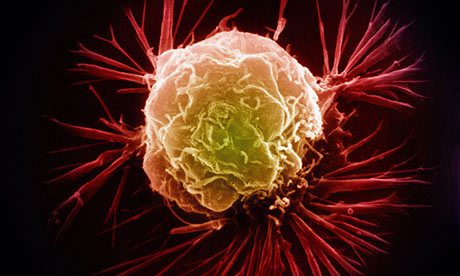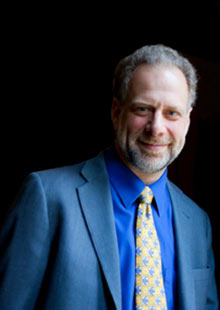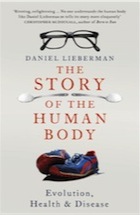
Breast cancer cell: women in the west are at far greater risk of developing the disease than their ancestors. Photograph: Rex/Cultura
Cancer is a disease everyone should worry about. Approximately 40% of Americans will receive a cancer diagnosis at some point in their lives and about one-third of them will die from the illness, making cancers the second leading cause of death, behind heart disease, in the United States and other western countries.
Cancers are an ancient problem and not unique to humans – they develop in other mammals, such as apes and dogs, although less frequently. Some cancers have been afflicting humans for millennia – cancer was firstnamed and described by the Greek physician Hippocrates (c460– c370BC). But there is little doubt that cancer is more prevalent today than in the past. The first analysis of cancer rates was published in the mid-19th century by Domenico Rigoni-Stern, chief physician of Verona hospital. Of the 150,673 deaths that Rigoni-Stern documented between 1760 and 1839, less than 1% (1,136) were from cancer, and of these, 88% were in women. Even if one assumes that Rigoni-Stern and his colleagues missed many cancer diagnoses, and that the disease's prevalence would have been higher had more Veronese lived to be older, these rates are at least 10 times lower than contemporary cancer rates.
Cancer is a tricky class of diseases to understand and treat because there are many types, each with different causes. All cancers, however, start from chance mutations in some errant cell. You probably have several of these potentially lethal cells already. Fortunately, most of them will remain dormant, doing nothing, but sometimes one of them undergoes additional mutations that cause it to function abnormally, cloning without restraint to form a tumour. Further mutations enable these cells to spread like wildfire from tissue to tissue, consuming resources meant for other cells, eventually causing organs to fail.
As Professor Mel Greaves of the Institute of Cancer Research has pointed out, cancer is actually a type of unrestrained natural selection gone awry within the body because cancers are selfish cells whose mutations give them a reproductive advantage over other, normal cells. In addition, just as environmental stresses promote evolution within a population, toxins, hormones and other factors that stress the body set up conditions that favour cancerous cells to reproduce more effectively than normal cells and to invade tissues and organs where they don't belong.
Here, however, the comparison to natural selection ends because the comparative advantages of cancer cells are short-lived and ultimately counterproductive. The factors that cause mutant cells to thrive within an organism also cause their host to die and they are rarely passed from one generation to the next. With the exception of the few cancers borne by viruses, cancer is thus a disease that recapitulates itself independently and slightly differently in almost every individual in which it occurs.
Cancers have many causes. One is simply the process of ageing, which gives more time for mutations to occur, and this explains why cancer risk increases with age. In addition, some cancers occur from inheriting unlucky genes that interfere with your cells' ability to repair mutations or to stop replicating. Another common and widespread set of causes for cancer includes toxins, radiation and other environmental agents that provoke potentially carcinogenic mutations. A few cancers are caused by viruses.
Here, however, our focus is on cancers caused by obesity and long-term positive energy balance – where calories taken in through food and drink are greater than calories used by the body. These "cancers of affluence" are most common in reproductive organs – especially breasts, the uterus and ovaries in women, and the prostate gland in men – but cancers of other organs such as the colon are sometimes also affected by a chronic surfeit of energy.
How and why energy balance contributes to reproductive cancers has been difficult to fathom because the causal relationship is indirect and complex. The first clues to an energy-related pathway for cancer appeared in the form of puzzling correlations between babies and breast cancer. Early physicians such as Rigoni-Stern noticed and wondered why nuns were far more likely to get breast cancer than married women. (For years, breast cancer was known as the "nuns' disease".)
These observations were later bolstered by large-scale studies that showed that a woman's chances of developing breast, ovarian, or uterine cancer increase significantly with the number of menstrual cycles she experiences and decrease with the number of children she bears. Decades of research now indicate that cumulative exposure to high levels of reproductive hormones, especially oestrogen, is a major cause of these associations. Oestrogen acts widely throughout the body but is a particularly potent stimulator of cell division in a woman's breasts, ovaries and uterus.
During each menstrual cycle, levels of oestrogen rise (as do other related hormones, such as progesterone), causing cells that line the wall of the uterus to multiply and enlarge in preparation for a fertilised embryo to implant. These surges also stimulate breast cells to divide. Thus, when women cycle they repeatedly experience high doses of oestrogen, which cause reproductive cells to proliferate, each time increasing the chances for cancerous mutations to occur and increasing the number of copies of any mutant cells.
However, when a woman becomes a mother, by getting pregnant and then nursing, she lowers her risk of breast and other reproductive tissue cancers by reducing her exposure to reproductive hormones. Breast-feeding may also help flush out the lining of the mammary ducts, removing potentially mutant cells.
 Daniel Lieberman: 'For millions of years natural selection favoured women who devoted whatever extra energy they had towards reproduction'.
Daniel Lieberman: 'For millions of years natural selection favoured women who devoted whatever extra energy they had towards reproduction'.
The association between oestrogen and some other oestrogen-related hormones with reproductive cancers highlights why these diseases are evolutionary mismatches influenced by a chronic state of positive energy balance. For millions of years, natural selection favoured women who devoted whatever extra energy they had towards reproduction, partly through the action of reproductive hormones such as oestrogen. Natural selection, however, never geared women's bodies for coping with long-term surfeits of energy, oestrogen and other related hormones. As a result, women today are very different and vastly more at risk of developing cancer than mothers from long agobecause their bodies are still functioning as they evolved, to have as many surviving children as possible. The result is that women who have more energy also have a greater cumulative exposure to reproductive hormones that, in abundance, elevate the risk of cancer.
There are two pathways that link energy and oestrogen to higher rates of reproductive cancers among women in developed countries. The first is how many menstrual cycles women experience. The average woman in countries such as the US, UK, and Japan starts menstruating when she is 12 or 13 years old, and she continues to menstruate until her early fifties. Because she has access to birth control, she gets pregnant only once or twice. Further, after she gives birth, she probably breastfeeds her babies for less than a year. All told, she can expect to experience approximately 350 to 400 menstrual cycles during her life.
In contrast, a typical hunter-gatherer woman starts menstruating when she is 16 and she spends the majority of her adult life either pregnant or nursing, often struggling to get enough energy to do so. She thus experiences a total of only about 150 menstrual cycles. Since each cycle floods a woman's body with powerful hormones, it is not surprising that reproductive cancer rates have multiplied in recent generations as birth control and affluence have spread.
The other key pathway that links chronic positive energy balances with reproductive cancers among women is through fat. Human females are especially well adapted to store extra energy in fat cells, which collectively act as a sort of endocrine organ to synthesise oestrogen that is released into the bloodstream. Obese women can have 40% higher oestrogen levels than non-overweight women. As a result, rates of reproductive tissue cancers among women are strongly correlated with obesity after menopause. In a study of more than 85,000 American women who were postmenopausal, those who were obese had a 2.5 times greater risk of developing breast cancer than those who were not overweight.
A relationship between energy surpluses and reproductive cancer may also apply to men, although less strongly. One of the many functions of the major male reproductive hormone, testosterone, is to stimulate the prostate gland to produce a milky fluid that helps protect sperm. Prostate glands are constantly producing this fluid. Several studies show that lifetime exposure to high levels of testosterone increases the risk of prostate cancer, especially in men who live in developed countries and are in frequent positive energy balance, presumably because they have abundant food, perform little physical labour and are in general good health.
Because reproductive cancers are linked via reproductive hormones to a surfeit of energy, physical activity has potent effects on the rates of some cancers. This makes sense: the more energy your body spends on physical activity the less it can spend on pumping out reproductive hormones. Women who are physically active have oestrogen rates about 25% lower than those who are sedentary.
These differences may partially account for why several studies have documented that just a few hours a week of moderate exercise substantially lowers the rates of many cancers, including those of the breast, uterus and prostate. Several of these studies have found that the more intensive the exercise, the lower the cancer risk. In one study of more than 14,000 women divided into low, moderate and high fitness groups, those who were moderately fit had 35% lower rates of breast cancer, and those who were very fit had more than 50% lower rates of breast cancer (after controlling for age, weight, smoking and other factors).
So an evolutionary perspective explains why the embarrassment of riches many people now enjoy elevates their levels of reproductive hormones, which, along with birth control, then increases the likelihood that cancers will evolve in their breasts, ovaries, uteruses and prostates. As economic development and processed-food diets sweep the globe, more people are shifting into positive energy balance, often extremely so, driving up the percentage of women and men with reproductive tissue cancers.
But are these reproductive cancers examples of dysevolution, a vicious circle in which we make the disease more common or severe because we treat the symptoms rather than prevent the causes? In most respects, the answer appears to be no and the way we treat cancers seems sensible. Should I ever get a diagnosis of cancer, I suspect I will want to employ every available weapon– drugs, surgery and radiation– to kill those mutant cells as early as possible and to prevent them from spreading throughout my body. These approaches have increased the rate of survival for a few types of cancer, including breast cancer.
In two respects, however, our approach to treating cancer may sometimes be dysevolutionary. The first is that cancer is more preventable than we often suppose. Reproductive cancer rates could be significantly reduced through more physical activity and changes in diet, and other types of cancers caused by the carcinogenic substances that we breathe and ingest could be reduced dramatically if we did more to regulate pollution and halt smoking.
In addition, just as treating bacteria with antibiotics sometimes creates conditions that encourages resistant strains of bacteria to evolve, treating cancers with poisonous chemicals may sometimes favour new drug-resistant cancer cells.
Thinking about cancers from an evolutionary perspective may help us devise more effective strategies to fight the disease. One idea is to promote benign cells to outcompete harmful cancerous ones. Another is to trap cancer cells by first promoting those that are sensitive to a particular chemical and then attacking them when they are in a vulnerable state. Since cancers are a kind of evolution within the body, perhaps evolutionary logic may help us find a way to better combat this scary disease.
This is an extract from The Story of the Human Body: Evolution, Health and Disease by Daniel Lieberman, published by Allen Lane, £16.99


No comments:
Post a Comment